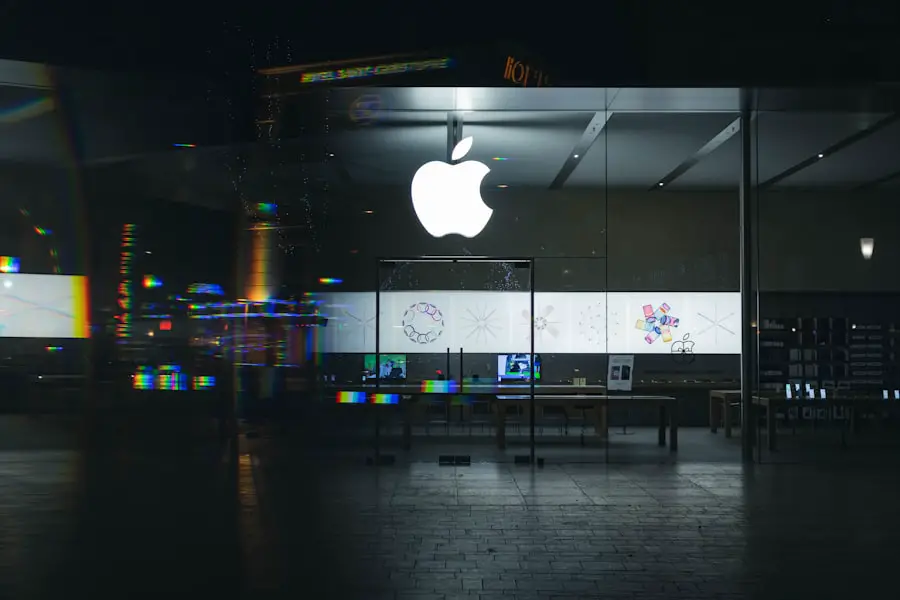The iPhone 13, launched in September 2021, marked a significant evolution in Apple’s smartphone lineup. With its sleek design, powerful A15 Bionic chip, and enhanced camera capabilities, the iPhone 13 quickly garnered attention from tech enthusiasts and everyday users alike. The device is available in four variants: the standard iPhone 13, the iPhone 13 mini, the iPhone 13 Pro, and the iPhone 13 Pro Max.
Each model caters to different user preferences, offering a range of features from compact size to advanced photography options. The introduction of vibrant color choices and improved battery life further solidified the iPhone 13’s position as a leading smartphone in a competitive market. One of the standout features of the iPhone 13 is its camera system, which includes sensor-shift optical image stabilization and improved low-light performance.
This advancement allows users to capture stunning photos and videos, even in challenging lighting conditions. Additionally, the device supports Cinematic mode, enabling users to create videos with a shallow depth of field and automatic focus changes. The iPhone 13’s display also received an upgrade, featuring Super Retina XDR technology that enhances brightness and color accuracy.
These innovations not only elevate the user experience but also set a new standard for what consumers can expect from mobile devices.
Key Takeaways
- The iPhone 13 is the latest model in Apple’s smartphone lineup, featuring a new A15 Bionic chip, improved camera system, and longer battery life.
- Apple typically provides software updates for iPhones for around 5-6 years, and hardware support for around 5 years.
- Factors such as technological advancements, user demand, and market trends can affect the length of support for the iPhone 13.
- Compared to previous iPhone models, the iPhone 13 is expected to receive software updates for a similar timeframe, but may have longer hardware support due to advancements in technology.
- Potential software updates for the iPhone 13 may include new iOS versions with enhanced features and security updates, while hardware updates could involve improved battery technology and camera enhancements.
- Technological advancements such as AI, 5G, and AR can impact the support timeline for the iPhone 13, potentially extending its lifespan through improved performance and capabilities.
- Tips for maximizing the lifespan of the iPhone 13 include using a protective case, regularly updating software, and avoiding extreme temperatures and physical damage.
- In conclusion, iPhone 13 users are recommended to take advantage of Apple’s support timeline by keeping their devices updated and well-maintained, while also staying informed about potential advancements and updates.
Apple’s typical support timeline for iPhones
Extended Support Timeline
Typically, Apple offers major iOS updates for its iPhones for about five to six years from the device’s initial release date. This timeline allows users to benefit from the latest features, security enhancements, and performance improvements, even years after their initial purchase.
Support for Older Devices
For example, the iPhone 6s, released in 2015, continued to receive updates until 2021, demonstrating Apple’s commitment to maintaining older devices. In addition to major iOS updates, Apple also provides security patches and bug fixes for devices that may not receive the latest operating system version, protecting users from vulnerabilities and ensuring their devices remain functional and secure.
Influence on Consumer Purchasing Decisions
The longevity of support is a significant factor that influences consumer purchasing decisions, as many users prefer investing in devices that will remain relevant and functional for years to come.
Factors that can affect the length of iPhone 13 support

Several factors can influence the duration of support for the iPhone 13. One primary consideration is hardware capabilities. As software becomes more advanced, it often requires more powerful hardware to run efficiently.
If future iOS updates demand higher processing power or more advanced features that the iPhone 13 cannot support, Apple may decide to discontinue updates for this model sooner than anticipated. The A15 Bionic chip in the iPhone 13 is robust and capable of handling demanding applications, but as technology progresses, there may come a point where it no longer meets the requirements of new software. Another factor is market dynamics and consumer demand.
Apple continuously evaluates its product lineup based on user feedback and market trends. If there is a significant shift in consumer preferences or if newer models are released with groundbreaking features, Apple may prioritize support for those devices over older models like the iPhone 13. Additionally, competition from other smartphone manufacturers can influence Apple’s strategy regarding software updates and support timelines.
Comparison with previous iPhone models and their support timelines
| iPhone Model | Release Year | Support Timeline |
|---|---|---|
| iPhone 11 | 2019 | Supported until 2023 |
| iPhone 12 | 2020 | Supported until 2024 |
| iPhone 13 | 2021 | Expected support until 2025 |
When examining the support timelines of previous iPhone models, it becomes evident that Apple has consistently provided long-term support for its devices. For example, the iPhone 7, released in 2016, received its last major update in September 2021, marking a five-year support period. Similarly, the iPhone X, launched in 2017, continued to receive updates until September 2022.
This trend suggests that users can expect a comparable support timeline for the iPhone 13. In contrast, older models like the iPhone 5s received updates for only about four years before being phased out. This shorter support period highlights how advancements in technology and software requirements can impact older devices.
As Apple continues to innovate and release new models, it is likely that the support timeline for the iPhone 13 will align with the patterns established by its predecessors while also considering the unique capabilities of its hardware.
Potential software and hardware updates for iPhone 13
As technology evolves, so too does the potential for software and hardware updates for the iPhone 13. One of the most anticipated software updates is the introduction of new features in future iterations of iOS. Apple typically unveils new operating system versions during its annual Worldwide Developers Conference (WWDC), where developers get a glimpse of upcoming features that may enhance user experience.
For instance, improvements in privacy settings, enhanced Siri capabilities, or new functionalities in apps like FaceTime could be on the horizon for iPhone 13 users. On the hardware front, while major hardware upgrades are less common after a device’s initial release, there may still be opportunities for enhancements through accessories or software optimizations. For example, Apple could introduce new camera features or computational photography techniques via software updates that leverage the existing hardware capabilities of the iPhone 13.
Additionally, improvements in battery management through software could extend battery life even further without requiring any physical changes to the device.
The impact of technological advancements on iPhone 13 support

Technological advancements play a crucial role in determining how long Apple can support devices like the iPhone 13. As new technologies emerge—such as artificial intelligence (AI), augmented reality (AR), and machine learning—software developers often seek to integrate these innovations into mobile applications and operating systems. If future versions of iOS incorporate features that require more advanced hardware than what the iPhone 13 possesses, it could lead to a reduction in support for this model.
Moreover, advancements in connectivity technologies such as 5G can also influence support timelines. As networks evolve and new standards are established, older devices may struggle to keep up with these changes. While the iPhone 13 supports 5G connectivity, future developments in this area could necessitate hardware upgrades that are not feasible within the existing framework of the device.
Consequently, as technology continues to advance at a rapid pace, it becomes increasingly important for users to stay informed about how these changes may impact their devices.
Tips for maximizing the lifespan of iPhone 13
To ensure that users get the most out of their iPhone 13 over its lifespan, several best practices can be adopted. First and foremost is regular software updates; keeping the device updated with the latest version of iOS not only enhances security but also ensures access to new features and optimizations that can improve performance. Users should enable automatic updates or regularly check for updates manually to stay current.
Another essential tip is to manage storage effectively. As apps become more sophisticated and media files grow larger, storage can quickly become an issue. Users should periodically review their apps and delete those that are no longer needed or used frequently.
Utilizing cloud storage solutions like iCloud can also help free up space on the device while ensuring that important files remain accessible. Additionally, taking care of the physical condition of the device can significantly extend its lifespan. Using protective cases and screen protectors can prevent damage from drops or scratches.
Regularly cleaning ports and ensuring that software runs smoothly by closing unused apps can also contribute to maintaining optimal performance over time.
Conclusion and recommendations for iPhone 13 users
For those who have invested in an iPhone 13 or are considering purchasing one, understanding Apple’s support timeline and how to maximize device longevity is crucial. With a robust hardware foundation and Apple’s history of providing long-term software support, users can expect several years of reliable performance from their devices. By staying informed about potential updates and adopting best practices for maintenance and usage, users can ensure that their investment remains valuable well into the future.
As technology continues to evolve rapidly, it is essential for users to remain proactive about their device’s health and performance. Engaging with online communities or forums dedicated to Apple products can provide valuable insights into optimizing usage and troubleshooting common issues. Ultimately, by taking these steps, iPhone 13 users can enjoy a seamless experience while benefiting from Apple’s ongoing commitment to innovation and customer satisfaction.
According to the terms and conditions outlined on about page or reach out to them directly through their contact page.
FAQs
What is the typical support lifespan for an iPhone model?
The typical support lifespan for an iPhone model is around 5-6 years from the time it is released.
How long will the iPhone 13 be supported?
The iPhone 13 is expected to be supported for at least 5 years from its release date, receiving software updates and security patches during this period.
What factors determine the length of support for an iPhone model?
The length of support for an iPhone model is determined by factors such as hardware capabilities, software compatibility, and market demand for the device.
What happens after an iPhone model reaches the end of its support lifespan?
After an iPhone model reaches the end of its support lifespan, it may no longer receive software updates or security patches from Apple, and some apps and features may no longer be compatible or functional.
Can the support lifespan of an iPhone model be extended?
The support lifespan of an iPhone model cannot be officially extended by Apple, but users can continue to use the device beyond its support period, although they may experience limitations in terms of software updates and app compatibility.










